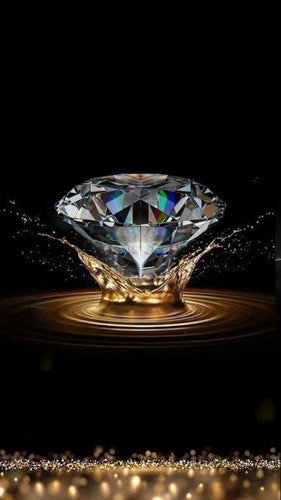Types of Gemstones in Jewelry and How to Distinguish Them
In the world of jewelry, gemstones are the elements that bring value and beauty to each design. Each gemstone not only adds a sparkling appearance but also carries its own meaning and significance. To choose the right piece of jewelry, it's important to understand the common gemstones and how to distinguish them. The following article will help you delve deeper into the gemstones frequently used in jewelry and the basic characteristics for identification.
1. Diamond
Diamonds are one of the most valuable and sought-after gemstones in jewelry. With the highest hardness on the Mohs scale (10/10), diamonds stand out for their intense light reflection, creating a brilliant sparkling effect.
-
How to Identify:
- Hardness: Diamonds can scratch almost all other types of stones.
- Brilliance: When exposed to light, diamonds reflect multiple colors.
- Breath Test: Diamonds don’t retain fog after being breathed on, unlike imitation stones like CZ (Cubic Zirconia).

2. Ruby
Ruby, known as the “red gem,” is a deep red gemstone belonging to the corundum family. Ruby is second only to diamonds in hardness, scoring 9 on the Mohs scale, and is highly prized for its vivid color.
-
How to Identify:
- Color: High-quality rubies have a bright, uniform red color.
- Inclusions: Natural rubies often have small inclusions; if flawless, it could be a synthetic ruby.
- Fluorescence: Natural rubies emit a red glow when exposed to ultraviolet light.
3. Sapphire
Sapphire is a gemstone available in many colors, but blue is the most common. Like ruby, sapphire also belongs to the corundum family and is known for its hardness.
-
How to Identify:
- Color: High-quality blue sapphires have an even blue color, neither too light nor too dark.
- Stone Veins: Natural sapphires often have small inclusions or veins.
- Fluorescence: Sapphires do not exhibit the strong fluorescence that rubies do under ultraviolet light.
4. Emerald
Emerald is known for its characteristic green color and belongs to the beryl family. Its hardness ranges from 7.5 to 8 on the Mohs scale, and natural emeralds often have internal fractures or inclusions.
-
How to Identify:
- Color: High-quality emeralds have a deep and even green color.
- Inclusions: Most natural emeralds contain inclusions or small internal fractures.
- Magnification Test: Use a magnifying glass to observe the natural characteristics inside the stone.
5. Amethyst
Amethyst is a popular gemstone known for its range of purple shades, from light to deep violet. With a hardness of 7 on the Mohs scale, amethyst is easily recognized for its soft yet striking color.
-
How to Identify:
- Color: Natural amethyst has a consistent and vibrant color.
- Transparency: High-quality amethyst has good transparency without cloudiness or inclusions.
6. Pearl
Pearls are organic gemstones formed inside the shells of mollusks. They come in various colors, from white, pink, and yellow to black.
-
How to Identify:
- Texture: Natural pearls feel slightly rough when rubbed against the teeth, unlike the smoothness of synthetic pearls.
- Luster: Genuine pearls have a natural luster, reflecting soft light.

(Photo source: https://www.pinterest.com/)
7. Topaz
Topaz is a gemstone available in a wide range of colors, including blue, yellow, pink, and colorless varieties. With a hardness of 8 on the Mohs scale, topaz is durable and ideal for jewelry.
-
How to Identify:
- Color: Natural topaz has clear, vibrant colors without excessive cloudiness or inclusions.
- Transparency: High-quality topaz has excellent transparency and is not cloudy.
8. Cubic Zirconia (CZ)
CZ is a synthetic gemstone widely used in jewelry due to its low cost and diamond-like appearance. At Perlamuse, all products use AAA-grade CZ stones – the highest quality, offering maximum sparkle and durability.
-
How to Identify:
- Brilliance: CZ has a brightness and sparkle similar to diamonds, but not as intense.
- Hardness Test: CZ is softer than diamonds, so it's more prone to scratches.

(Photo source: https://www.pinterest.com/)
Conclusion
Identifying gemstones in jewelry not only helps you choose the right products but also ensures the value and quality of the jewelry you own. Visit Perlamuse to explore our premium jewelry collections featuring AAA-grade CZ stones and a variety of other fine gemstones, meticulously crafted to bring you radiant and elegant beauty.
Browse and shop for jewelry at Perlamuse today!

